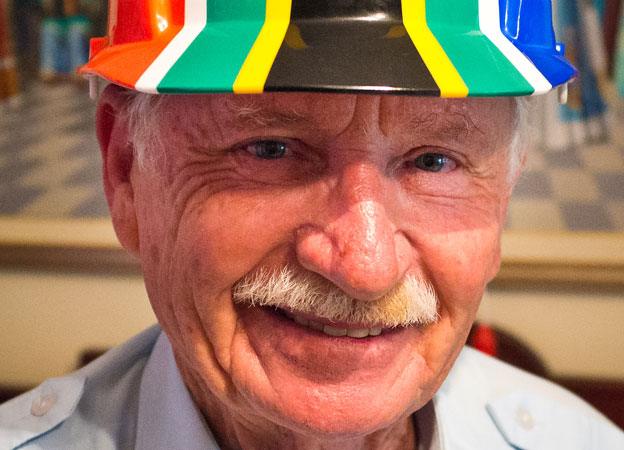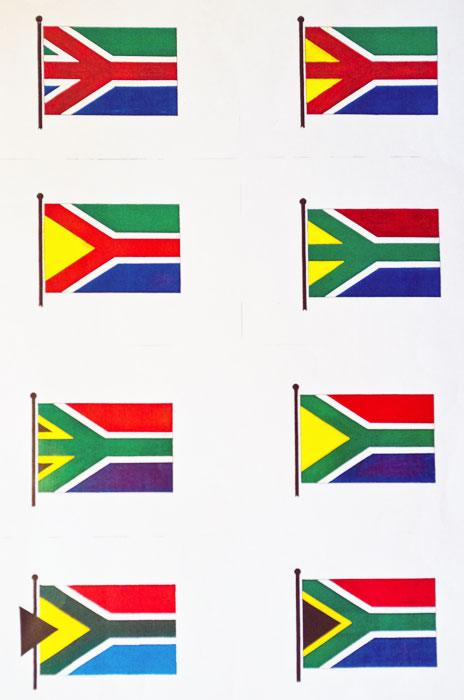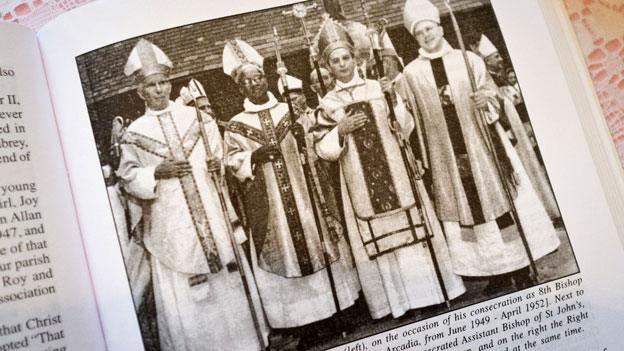Fred Brownell: The man who made South Africa's flag
- Published

The multi-coloured flag of modern South Africa is a symbol of its post-apartheid rebirth. But while Nelson Mandela led the country on a "long walk" to freedom, the creation of the flag 20 years ago was a frantic sprint by an unsung hero, writes Xin Fan.
On a Saturday night at the end of February 1994 Fred Brownell's phone rang. The voice on the other end asked him to get a new national flag designed - within a week.
"It scared the living daylights out of me," says Brownell, now 74 and living in retirement in Pretoria.
Brownell was state herald, and had long known that the emerging new South Africa would need a new flag, but until this point he had not been asked to play a central role.
Initially, members of the public had been asked for their ideas. Some 7,000 sketches had been sent in, but none was judged appropriate. Then the authorities had turned to design studios. That too proved fruitless.
The months had passed by and now the first democratic elections - when the new flag was expected to be fluttering in the South African breeze - were little more than eight weeks away. Hence the urgent Saturday night call to Brownell.
Fortunately, he had already given the subject some thought.
He had been asking himself for some time what the new South African flag should look like. But his sketches had all ended up in the wastepaper basket until one day in August 1993, when he sat listening to an "interminable speech" at an international flag conference in Zurich.
"My mind started wandering," he recalls. "And then it struck me - aren't we looking for convergence and unification?" The convergence of the disparate groups within South African society, and their unification in one democratic state.
He flipped over the conference programme and started sketching. Three arms came in from the flagpole side of the flag (the "hoist") and became one.
"I was struck by the extent it resonated with what Mandela had in mind. 'Yes, it might work!' I thought," Brownell remembers.
His first idea was for the three-pronged shape to be coloured red, with green and blue at top and bottom, but he soon concluded it looked better with the colours switched around - the three-pronged shape in green, red at the top and blue at the bottom.
But the flag needed other colours too. "I think one must realise that red, white and blue or orange white and blue harked back to South Africa's colonial heritage," Brownell says.
Gold was the first he added, then black - both colours found on the flags of the African National Congress, the Zulus' Inkatha Freedom Party, and various other political groupings in South Africa.

Brownell's sketches show the evolution of his ideas
The final design also used a particular orangey shade of red known as chilli red, which is mid-way between the colours of the British and Dutch colonial-era flags but at the same time reminiscent of South Africa's coral trees, Brownell says, and the flat hats worn by married Zulu women.
The only other change to the design was made at the suggestion of Brownell's daughter, Claire, a young schoolteacher.
"Dad, use your brain!" she said. "People will stand that on its head and turn it into the nuclear peace sign. The middle leg must go."
The three arms converging into one, became just two arms converging into one.
So when Brownell got the call asking him to have the issue "solved within the week" he was not starting completely from scratch.
In the end it came down to five proposals, two of them Brownell's. Of the others, one was based on an idea from the ANC, another came to a member of the committee Brownell had hastily convened in the middle of a plane flight.

The choice was put to State President FW de Klerk, who said it was not a decision he could take alone and called an impromptu cabinet meeting. "I noticed their eyes", says Brownell. "They were being drawn to my design."
Sure enough it was one of his drawings that was selected. Officials then contacted ANC negotiator Cyril Ramaphosa, and a tense wait ensued. His approval finally came through later that afternoon.
Many years later Brownell learned that Ramaphosa too had not wished to act alone, and had contacted Nelson Mandela, then in Rustenberg in the north-east of the country, to get his personal blessing.
"A design had been sent to Mandela by fax. Somebody on the other end had to run down to the stationery shop, grab some colouring pencils, and colour in the flag," says Brownell.
Luckily, Brownell says, "Mandela was happy with it."

That same day, 15 March 1994, the design was unanimously adopted by the Transitional Executive Council, which asked President de Klerk to issue a proclamation adopting the national flag. But for reasons that Brownell still cannot explain, the proclamation was made only on 20 April, seven days before the election.
During the wait, Brownell says, "lots of us were going frantic".
"Flag manufacturers were screaming high and low. South Africa could only produce 5,000 flags per week, and at least around 100,000 were needed for April 27th to fill every flagpole in the country."
Some historical flags

Boer republics of Orange Free State (top left) and Transvaal (bottom left), and the flags of the Union of South Africa, 1910-1928 (top right) and 1928-1994 (bottom right)
Manufacturers in the Netherlands helped save the day, although not before exhausting Europe's entire stock of flag material and having to import it from Japan.
"Public reaction was muted, originally," recalls Brownell. "But once Mandela was inaugurated on 10 May, with the flags draped over Union Buildings in Pretoria, people warmed to the fact they had a new president, with a new flag to go with him.
"The level of acceptance exceeded my wildest expectations," he says.
Asked what might have prompted him to come up with his initial three-pronged design, Brownell reflects that it was probably embedded in his mind from childhood.
"I grew up in the Anglican church and this particular design was in fact incorporated into the classical chasubles [outer vestments] worn by priests in both the Catholic and Anglican church," he says.

"In recent years chasubles have changed very much, but that was the classic design."
Twenty years on, Brownell is quietly pleased with his work.
He still sees the "convergence and unification" of a diverse country reflected in the flag, and insists there is no-one in South Africa who does not recognise in it colours they hold dear.
"I feel happy to have contributed in some small way."
Photographs and video by Kelvin Brown (except for the AFP picture of Nelson Mandela)
Follow @BBCNewsMagazine, external on Twitter and on Facebook, external